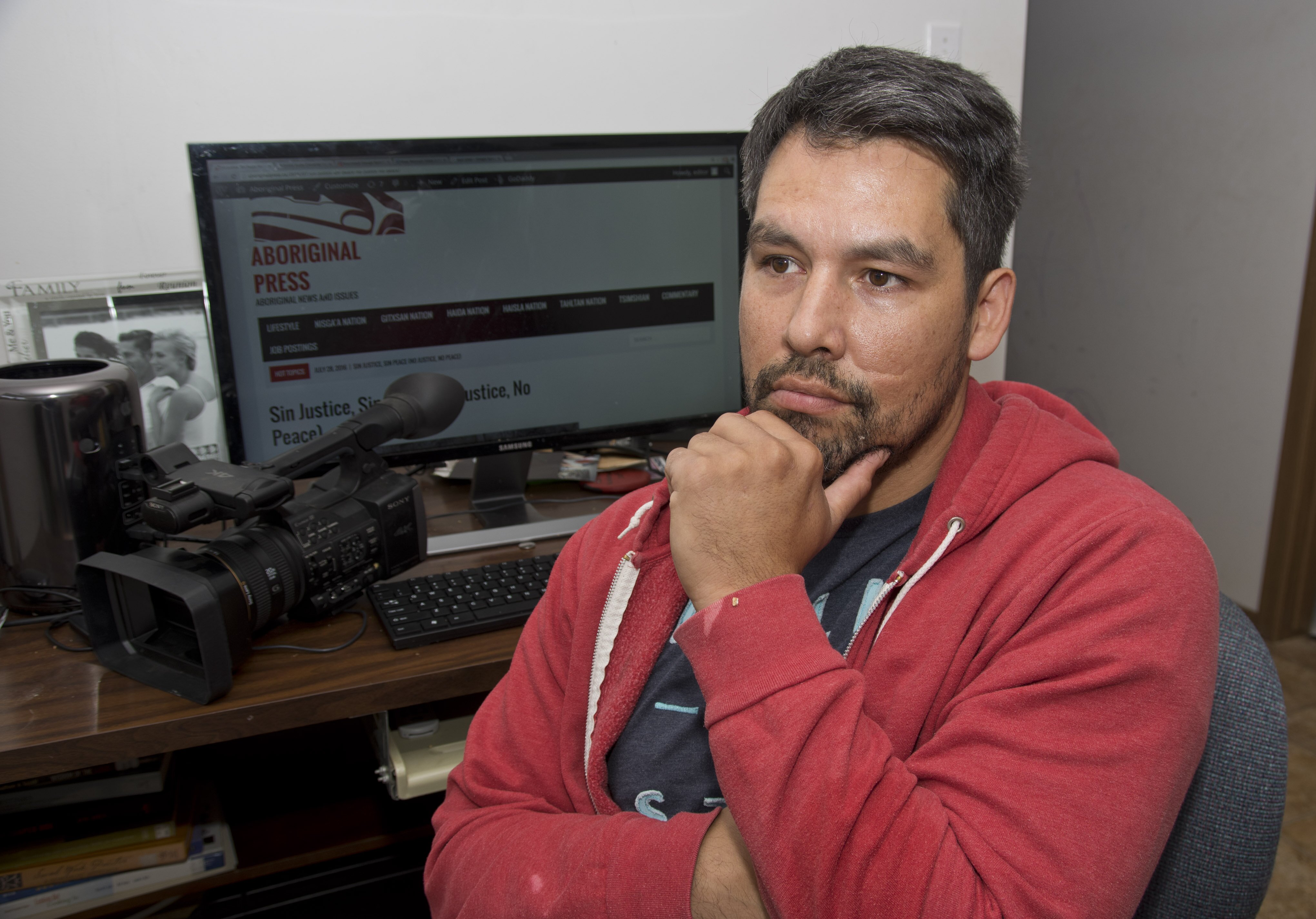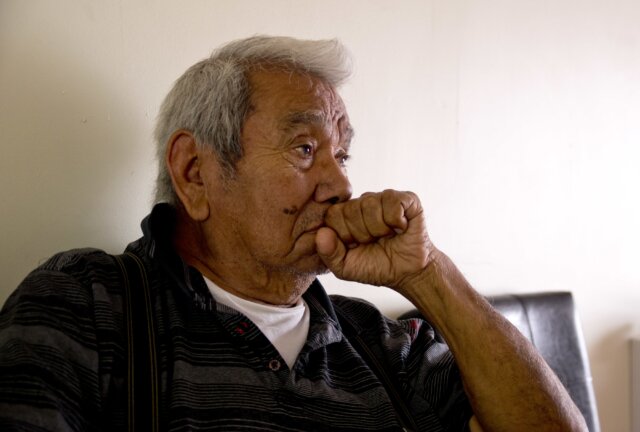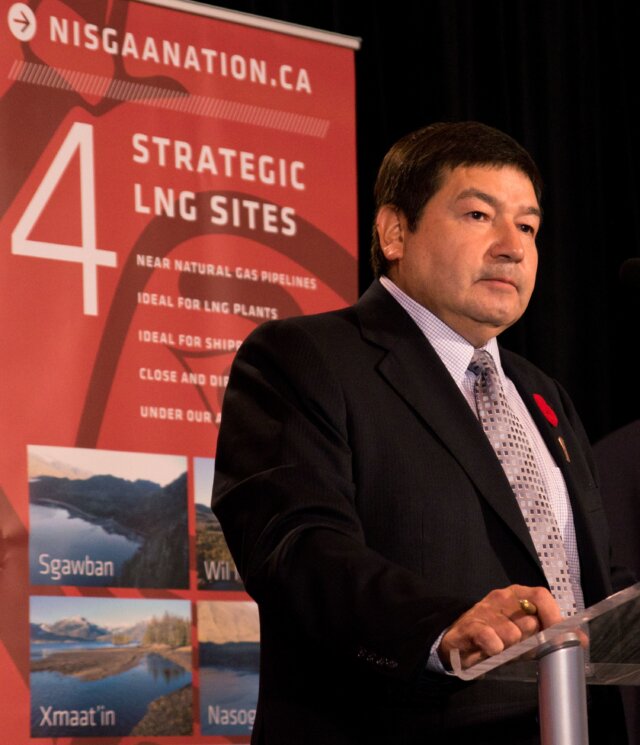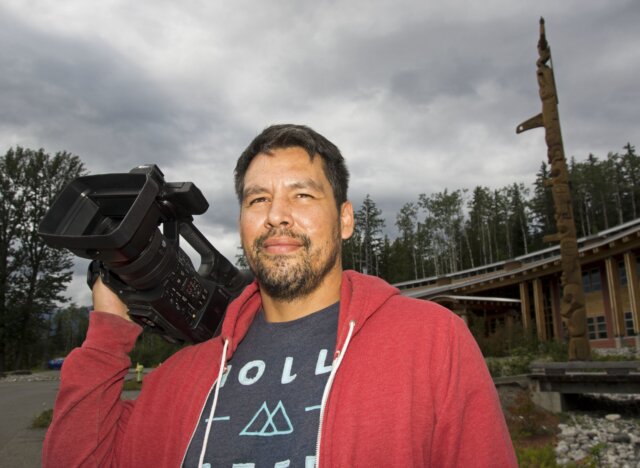The new press on the block
First Nations community members are pushing for post-treaty press freedom, but a lack of journalism training opportunities is holding back those trying to hold their governments to account.

Noah Guno, owner of the micro news website Aboriginal Press, sits in his basement in the Nisga’a village of Gitlaxt’aamiks, B.C., editing a travel news story a writer emailed to him earlier in the day.
The computer screen glare is the room’s only light, illuminating a dictionary on Guno’s desk. He looks up a word, then starts typing again, the click of the keyboard breaking the room’s silence.
Guno’s village, about an hour north of Terrace, B.C., is also home to the Nisga’a Lisims government building. It is where the Wilp Si'ayuukhl Nisga'a, or the Nisga’a legislature, is set to begin a three-day session of meetings the next day. When the Nisga’a treaty was enacted 13 years ago — making the Nisga’a Nation the first modern-day treaty nation in Canada — this legislature became the home of an effectively independent government within Canada’s borders that presides over the political and financial affairs of more than 7,000 Nisga’a citizens, most of whom live off reserve.
"I know government meetings are important, and that the decisions made at them affect our people. But I don’t know how to cover them."
Fifty-nine tribes in British Columbia are at various stages of treaty negotiations that could lead to each becoming a hybrid democracy similar to the Nisga’a Nation. But as Discourse reported earlier in this series, it remains unclear whether the press has the same freedom to report on Indigenous government in the same way journalists have a right to cover other public bodies in Canada.
What is clear is that little press culture exists in most communities like those in the Nisga’a Nation, in part because the communities are so remote that journalists rarely show up to cover meetings such as those of the Nisga’a legislature. Some First Nations community members, like Guno, are pushing for post-treaty press freedom by creating micro news websites, email newsletters and Facebook groups. But most of these concerned citizens aren’t journalists, and a lack of journalism training opportunities is holding them back from holding their governments to account.
Case in point: Guno did not attend the next day’s Nisga’a legislature meeting. “I know those meetings are important, and that the decisions made affect our people,” says Guno, a married father of three. “But I don’t know how to cover them. I wouldn’t know what to write if I went. I need to learn.”
More than 35 story ideas were identified at that meeting that will likely not be investigated because of this lack of journalism capacity in the region.
A tradition of storytelling and accountability
The Nisga’a Nation isn’t the only community struggling with a lack of journalism infrastructure. Across Canada, communities are experiencing a hollowing-out of journalism capacity as the industry struggles with collapsing classified and display advertising revenues as a result of digital disruptors like Craigslist, Facebook and Google. In B.C. alone, 23 newspapers have either closed or reduced circulation in the last six years.
In the absence of mainstream journalism, Facebook is becoming a go-to source of information for Nisga’a citizens, particularly for the approximately 60 per cent who live in urban centres. Ginger Gosnell-Myers runs a Facebook group called Nisga'a Democracy and Governance, where its more than 1,500 members share information about the Nisga’a. But, like Guno, Gosnell-Myers is not a journalist.

Though the Nisga’a lack formally trained journalists today, telling stories and holding people accountable aren’t foreign concepts. Nisga’a elder George Williams says these things are historically part of Nisga’a culture.
Before the Indian Act and residential schools, Nisga’a people lived according to ancient cultural codes, according to Williams, 82, who was raised by his aunt and uncle after his mother’s death in 1935. Those who violated Nisga’a laws (a set of rules called Ayukwhl Nisga'a that were created by a tribunal of Nisga’a chiefs and instilled by clan matriarchs) were held accountable by sub-leaders and tribal policemen.
“If I did something wrong then I would have to put up a feast, carry out a ritual and ask for forgiveness,” Williams says. The focus wasn’t punishment. “It was done in a way to pick a person up.”
News wasn’t a completely foreign concept either, Williams says. While there isn’t a Nisga’a word that means “news” exactly, “adawak,” which translates to “story of a clan or sub-clan house,” is close. Instead of journalists, chiefs had messengers, called “hits” in Nisga’a, who would travel to neighbouring villages to share news and events.
Training as a solution
So for those who are working to improve access to information and accountability in First Nations communities, this is the challenge. How can communities reconcile traditional concepts of storytelling and accountability with modern democratic values? In other words, how can Indigenous communities take the best from the western concept of journalism while preventing further cultural harm associated with previous colonial practices?
"Indigenous people don't need to be told how to tell good stories, but they do need to be taught journalism fundamentals so they can access mainstream media."
This tension is familiar to Rachel Pulfer, the executive director of Journalists for Human Rights (JHR), an international media development charity and non-governmental organization based in Toronto. In communities with no independent media, stories go untold and tension goes unabated, Pulfer says. And when those stories are told by mainstream media, they can be incorrect and misrepresentative. Good journalism done right in First Nations doesn’t spark lateral violence.
Nor does journalism have to undermine band councils, she argues. "Often what we see is that [journalism] reinforces confidence in what the chief and council are doing because people feel they have a voice," Pulfer says. "When they see responsiveness to that voice, that reaffirms confidence in the [council’s] mandate."
For the past several years, JHR has worked to build journalism infrastructure in First Nations communities through its Indigenous Reporters Program. The program is based on JHR’s long-running work in Africa and the Middle East, where JHR media trainers work with journalists to strengthen press freedom in post-conflict regions. JHR employs the principles of conflict-sensitive reporting, which has been honed in war-torn countries like Liberia and Sierra Leone. Stories are written using careful, neutral language and are scrupulously balanced and fair. The goal is to open up conversations about issues that spark conflict with an eye to solving them instead of exacerbating them. Media trainers are taught to be extremely aware of community fault lines, because one badly-written story can have devastating consequences in a region recovering from conflict, Pulfer says.
The Indigenous Reporters Program has taught the basics of journalism to First Nations members in 16 northern Ontario communities. Trainees are encouraged to sell stories to media outlets in order to earn freelance fees. Media trainers, who spend eight months embedded in the community and paid by the Ontario Trillium Foundation, also work on media literacy with the community and its band council to educate them about the role media can play in holding those in power accountable.
"Journalism reinforces confidence in what the chief and council are doing because people feel they have a voice, especially when they see responsiveness to that voice."
"This leads to better governance outcomes, which we tend to see in other parts of the world," Pulfer says. JHR hopes to expand the program into Manitoba, Saskatchewan, Yukon and B.C.
In order to work with a community, JHR requests access from the band council through a memorandum of understanding (MOU). This could potentially pose a problem if the band council disagreed with a trainee’s reporting. "We haven't had a scenario where a chief and council who have hosted a media trainer decided that the trainer was a troublemaker and asked them to leave," Pulfer says. One First Nation did pull out of their agreement after signing an MOU because of last-minute cold feet, she says. For the Nisga’a, who have a modern treaty, this approach would likely be different.
Longtime CBC Thunder Bay reporter Jody Porter has observed and consulted with the program since its infancy. She believes that the intention of the program is positive, but transposing a program from Africa to a Canadian context doesn’t fully address First Nations communities’ needs.
The stated goal of the program is to increase the quality and quantity of First Nation stories and voices in mainstream media. But producing journalism from these communities and doing journalism for these communities are different things, Porter says. “Do you want to tell Indigenous stories to sell to mainstream media, or do you want to inform people [in your own community] so that they can make good decisions?” she asks. The goal is not, in other words, to address the systemic issue of news poverty in these communities.
“Indigenous people don’t need to be taught how to tell good stories, but they do need to be taught journalism fundamentals [to access mainstream media],” says Porter. But achieving that does not ensure trainees’ stories will sell. According to Porter, mainstream media doesn’t have a huge appetite for Indigenous stories. “All of us who have tried to tell these stories have hit roadblocks — and we have access to the mainstream,” she says.
Nisga’a government welcomes media questions
Back in Nisga’a territory, it appears that the problem is not that Nisga’a leaders block access to journalists but that there aren’t any journalists to block.

Mitchell Stevens, the Nisga’a Lisims government’s now-former president (Eva Clayton won the presidency on Nov. 2, 2016), says he’s always willing to talk to the press, as long as their stories are rooted in fact. “We have always been very up front in everything that we do. We don’t mind speaking to anyone,” Stevens says. After taking office in 2010, Stevens was interviewed by reporters from the Terrace Standard, Canadian First Nations Radio, CBC, The Canadian Press, The Tyee, The Globe and Mail and the Vancouver Sun.
But after the news event of his appointment passed, the journalists disappeared. With the Nisga’a territory an hour’s drive from Terrace and eight hours’ drive from Prince George, no reporters have the ability to cover the Nisga’a consistently.
"They're a government. They're not journalists. It's not their job to write both sides of the story. It's up to us to create that."
Despite the lack of journalists, Stevens argues that the Nisga’a legislature is transparent with its own website, Facebook, Twitter and YouTube presence. “All decisions, and our annual budget, are posted on there. Every piece of our legislation is posted on there. The Nisga’a Government Act, the Nisga’a constitution,” Stevens says. “If people want factual information about us, before they do anything in the press about it they should go to that site and look it up.”
Stevens worries that information being spread on social media is inaccurate. He says that he sees posts that say the government is overspending and the nation is going broke. “We’re not broke,” he says, referencing a $750-million trust fund that the nation got during their treaty settlement. “People shouldn’t get their noses out of joint.”
But Stevens doesn’t necessarily see responding to reporters’ requests as part of his job. “Once I’ve reported to my executive, I have discharged my duty as president to them. They carry that responsibility to inform citizens,” he says.
The social cost of news
Nearby in Gitlaxt'aamiks, Noah Guno finishes editing his travel story. He touches up a picture using Photoshop, then saves a first draft of the story on his website before turning the computer off. Guno walks out of his house and lights a cigarette, inhaling deeply before blowing smoke into the warm night air. He pauses for several seconds before speaking.
“I was a naysayer. It came from lack of knowledge about what [the Nisga’a Lisims] government was doing,” he says. “Then it occurred to me that they’re a government. They’re not journalists. It’s not their job to write both sides of the story. It’s up to us to create that.”
Guno says he knows his mettle could be tested if he writes about an issue involving tension in a community where he knows everyone, and he ponders the impact it could have on him and his family. “I’ve already had a guy say to me, ‘Watch it, Noah. Be careful what you write.’”

But the alternative, relying solely on the Nisga’a government itself, or on mainstream media that don’t cover Nisga’a news consistently, doesn’t sit well with him. “My job is to get the information out,” he says.
“I’m going to have to write it like it is. I’m going to have to weigh the facts and circumstances that allow people to find the truth,” Guno says, describing a job that, despite his worries about his lack of training, sounds a lot like journalism.
But there’s been an interesting development in Guno’s life. After this story was completed, he ran for and won a seat on the Gitlaxt'aamiks Village Government council. He was sworn into office on Nov. 17 and has passed editorial control of Aboriginal Press to two recently-hired writers.
“I’ve written about issues and now I have a chance to get in and help move them, only now as a councillor,” he says. “I used to say people should spend some time as journalists to understand them,” he says. “I need to spend some time in office as a councillor to understand that.”
